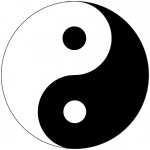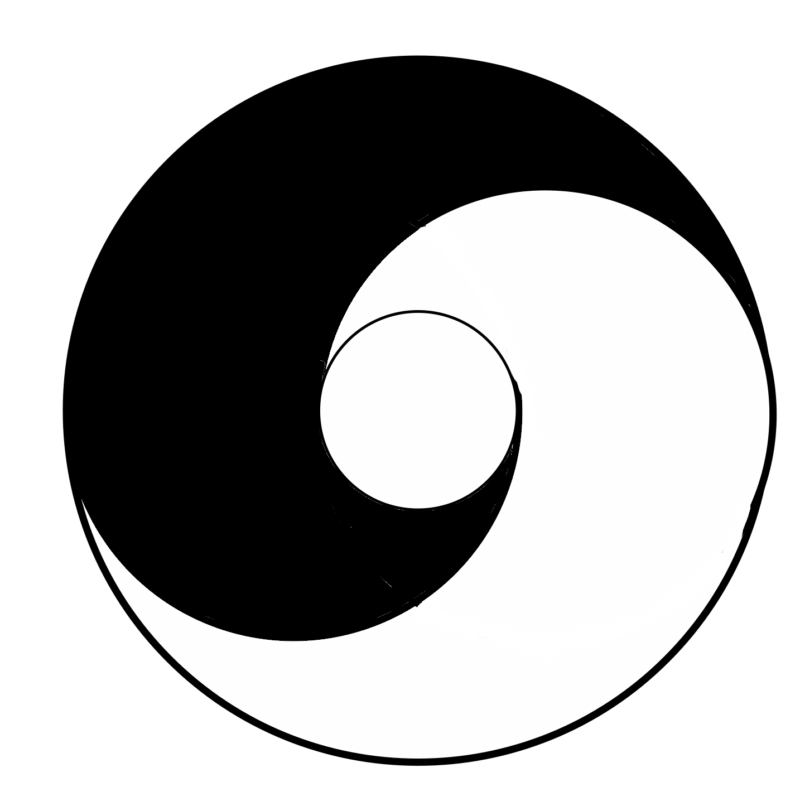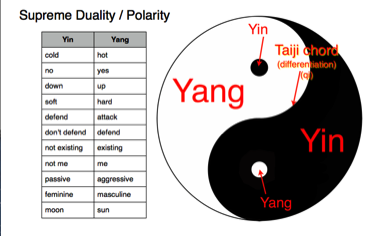Basic Terminology: Tai chi, tai chi chuan, taijiquan
Tai chi / Taiji
“Supreme Duality”
In English, it is written as “tai chi” and pronounced “tai chee”
It can be written in different ways.
- Tai chi (the common English spelling)
- Taiji (used typically in scholarly writing)
- 太极 (simplified Chinese)
- 太極 (Full form Chinese)
- Tàijí (pinyin romanization)
It literally translates as: “Supreme Pole”, or “great extremity”, or “Universal duality”
Tai chi has two popular meanings. It is commonly used as an abbreviation of tai chi chuan (taijiquan), the name of a martial art and exercise system. But the older meaning refers to the philosophical concept from which the art gets its name.
Tai chi / Taiji (the philosophical concept)
In the simplest terms, Tai chi refers to the philosophy of yin and yang, mutually dependent opposites.
It is the universal polarity, or “duality” that defines the phenomenal universe.
Everything that we experience can only exist relative to something else. Up and down, left and right, hot and cold, existing and not existing, me and “not me,” day and night, past and future, etc. The present moment only exists relative to the past.
According to this idea, which is found throughout many different schools of thought and different religions, the phenomenal universe does not have an inherent existence. Everything that exists or is experienced, only exists as a relationship between mutually dependent opposites.
NOTE: Some people mistakenly equate yin and yang with good and evil. In fact, something that is deemed to be “good” will have elements of both yin and yang, as will something that is deemed to be “evil.” If we want to think about good and evil as they relate to yin and yang, then we should look at how the effect of the balance and interaction of yin and yang has on people, things, and events.
There have been various graphical representations of the “Tai chi” idea. Below are two of the simplest and most common. There are other more complex diagrams which include the five element theory and/or eight trigram theory. But we don’t need to get into that now.



Everything that exists in the phenomenal universe can only exist relative to something else.
Up and down, left and right, inside and outside, masculine and feminine, day and night, hot and cold, strong and weak, hard and soft, tall and short, flexible and stiff, etc.
These mutually dependent opposites are relative to each other, but they are not interchangeable or absolute. For example, you could say hot is yang relative to cold, but it would be wrong to say that hot is yang relative to short. Also, “hot” is considered yin relative to “even hotter.” In fact, absolute yin and absolute yang are impossible in the phenomenal universe. As something approaches one extreme, it becomes its opposite. Extreme yin leads to yang just as extreme yang leads to yin.
While we are at this, you could say that Masculine is yang relative to Feminine. But you would be wrong to say that Masculine is yang relative to soft, or that strong is yang relative to female. One can be female and strong, or male and weak. Everything is contextual.
Tai chi is based on a fundamental concept of reality. But being fundamental does not mean it is simplistic. To truly understand the nature and relationships of yin and yang requires subtly, depth, and nuance. The concept of Yin and Yang may seem like a simple concept. But it is not enough to use so-called common sense to interpret and apply it. We still need to engage system 2 thinking. In a universe filled with complex diversity, and diverse complexity, common sense is never enough.
So, that is one meaning of tai chi. It refers to the philosophy of yin and yang.
2) A common abbreviation of Tai chi Chuan (Tajiquan, 太极拳, 太極拳, tàijíquán)
The exercise system or martial art based on the philosophy of yin and yang.
Since “Quan” 拳 translates as “fist.” Some people will say that “tai chi chuan” is the martial art, while “tai chi” is the exercise practiced just for health. This is a misinterpretation. There are exercises called “chuan” 拳 which are not martial arts. There are also several martial arts which do not use the word Chuan 拳 in the name.
“Tai chi” is used to refer to the art in general, whether or not the teachers or students have any interest in the martial aspects.
Tai chi chuan can refer to a complete system, or the solo exercise routines practiced by themselves.
At the core of tai chi practice are slow and meditative routines called taolu or “forms.” Some routines take a few minutes to go through, while others could take up to an hour.
The complete system includes basic exercises, meditation, posture practice, breathing, stretching, routines of varying complexity, the use of different apparatus like balls, sticks, fans, swords, poles, and more. There are solo as well as two-person exercises.
Yin and Yang in the art of Tai chi.
While practising tai chi as for health, for meditation, for self discovery, for sport, or for martial arts, the interaction of yin and yang are of key importance. Yin and yang are as fundamental to understanding the art form as the relationship between energy and matter is to understanding physics.
The study of Yin and Yang shows us that weakness can be a strength, strength can be a weakness, and extremes can lead to their opposites. Future lessons will delve more deeply into the relationships between yin and yang. For now, however, let’s just consider the example of a tree.
Consider a tree. As a seed, its small size, light weight, and edibility make it vulnerable. But these qualities allow it to be spread around by wind, birds, water, and animals. As it sprouts, the combination of yin and yang can enable it to push through pavement, move stone, and reach for the sun. As a sapling, its is small and pliable, still vulnerable to predation, but able to recover from being bent and abused. As the tree grows, it becomes stronger less vulnerable, but more appealing to the lumber industry. The tallest tree in the forest has many yang qualities such as strength, hardness, height, and thickness. These are qualities which, if balanced with internal yin qualities, and in harmony with its environment, will allow it to survive for centuries. But if the yang qualities are out of balance with the environment, can make it brittle, and prone to destruction by rot, lightning, wind, and gravity. Eventually, the tree falls. The extreme yang qualities, lead to yin qualities, and the cycle continues.
We, as humans, are the most helpless of animals when we are born. The yang nature of our brains means that we have to be born before we are physically capable of any sort of self preservation. We rely on our vulnerability to inspire the protection and sympathy of every adult we encounter. As we grow, we lose some of that sympathy. Our life becomes a struggle to maintain the harmony of yin and yang, both internally and with our environment.
The art of tai chi is the art of harmony. It is dynamic tranquility, and the constant navigation of chaotic balance. Our health and vitality depends on managing the changes in the world by seeking balance within ourselves and with the world around us. This can refer to structural integrity, flexibility, strength, homeostasis, awareness, intention, diet, sleep, exercise, education, socialization, communication, and so on.
As a martial art, the first stage is the study of the mind and body. Balance is not merely what you are defending. It is what you defend yourself with. Life is such that most of us carry a great deal of conflict within. So much so that we are, for all intents and purposes, already outnumbered by the time we face a single opponent. So, first we must learn to stop fighting ourselves. Only then can we learn to stop fighting the opponent.
The goal of tai chi, as with any traditional martial art, is tranquility. We cannot achieve this by being passive.